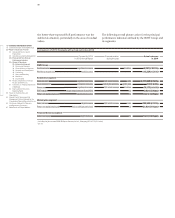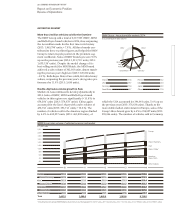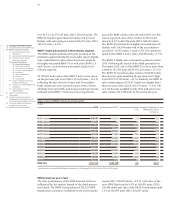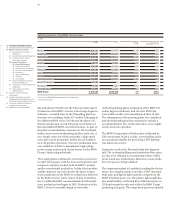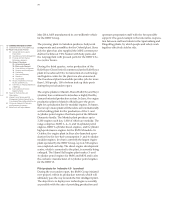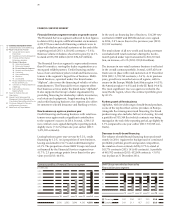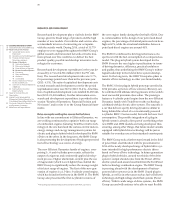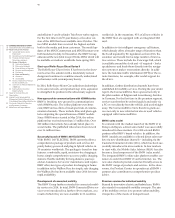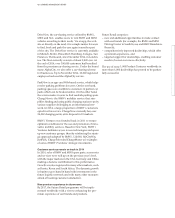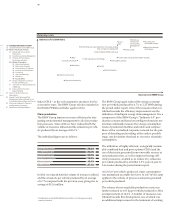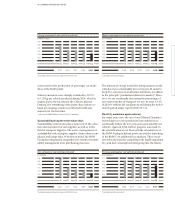BMW 2014 Annual Report Download - page 38
Download and view the complete annual report
Please find page 38 of the 2014 BMW annual report below. You can navigate through the pages in the report by either clicking on the pages listed below, or by using the keyword search tool below to find specific information within the annual report.
38
18 COMBINED MANAGEMENT REPORT
18
General Information on the
BMW
Group
23 Report on Economic Position
23 General and Sector-specific
Environment
26 Overall Assessment by Management
26 Financial and Non-financial
Performance Indicators
29 Review of Operations
29 Automotive Segment
35 Motorcycles Segment
36 Financial Services Segment
38 Research and Development
40 Purchasing
41 Sales and Marketing
44 Workforce
45 Sustainability
49 Results of Operations, Financial
Position and Net Assets
61 Comments on Financial Statements
of BMW AG
64 Events after the End of the
Reporting Period
65 Report on Outlook, Risks and
Opportunities
82 Internal Control System and Risk
Management System Relevant for
the
Consolidated Financial Reporting Process
83
Disclosures Relevant for Takeovers
and Explanatory Comments
87
BMW Stock and Capital Markets
Research and development play a vital role for the BMW
Group, given its broad range of products and the high
number of new models. Our vehicles and services also
set standards in terms of connecting car occupants
with the outside world. During 2014, a total of 11,779
employees were engaged throughout the BMW Group’s
global
research and innovation network at twelve loca-
tions
spread over five countries, to deliver the best
product quality possible and develop innovative tech-
nologies
for customers.
Research and development expenditure for the year de-
creased by 4.7 % to € 4,566 million (2013: € 4,793*
mil-
lion). The research and development ratio was 5.7 %,
0.6 percentage points lower than in the previous year
(2013: 6.3 %). The ratio of capitalised development costs
to total research and development costs for the period
(capitalisation ratio) was 32.8 % (2013: 36.4 %). Amortisa-
tion of capitalised development costs totalled € 1,068 mil-
lion (2013: € 1,069 million). Further information on re-
search and development expenditure is provided in the
section “Results of Operations, Financial Position and
Net Assets” and in note 11 to the Group Financial State-
ments.
Drive concepts: setting the course for the future
In line with our commitment to Efficient Dynamics, we
are working continuously to optimise both our range
of
combustion engines featuring TwinPower turbo tech-
nology on the one hand and the various electric motors,
energy storage and energy management systems for
electric and plug-in hybrid vehicles developed for BMW
eDrive on the other. In the long term, the BMW Group
is also promoting the development of hydrogen-powered
fuel cell technology as a source of energy.
The new Efficient Dynamics family of engines, com-
pris
ing 3-, 4- and 6-cylinder power units, reflects the
output of a rigorous and consistently applied develop-
ment process. Higher aluminium content plus the use
of magnesium (which is even lighter) has enabled the
BMW Group to significantly reduce the average weight
of its latest range of engines. The first of this new gen-
eration of engines is a 1.5-litre, 3-cylinder petrol engine,
which has found its first home in the BMW i8. The BMW
Group also presented the first 4-cylinder versions of
RESEARCH AND DEVELOPMENT
the new engine family during the first half of 2014. Due
to commonalities in the design of our petrol and diesel
engines, the percentage of identical parts used can be as
high as 60 %, while the structural similarities between
petrol and diesel engines are around 40 %.
The BMW i8 combines the driving performance of a
sports car with the fuel consumption of a compact-class
model. The plug-in hybrid system developed for the
BMW i8 meets the very highest specifications in terms
of driving dynamics, efficiency, practical usefulness
and quality, thus underlining the BMW Group’s techno-
logical leadership in the field of drive system
develop-
ment. In the long term, the BMW Group also plans to
transfer eDrive technology to other core brand models.
The BMW 3 Series plug-in hybrid prototype unveiled in
2014 provides a preview of how extreme efficiency can
be combined with ultimate driving pleasure in the world’s
most successful premium-class sedan. The prototype
features a 4-cylinder petrol engine from the new Efficient
Dynamics family with TwinPower turbo technology
combined with an electric drive system. The outcome is
a car that delivers sporty driving dynamics similar to
being
behind the wheel of a conventionally powered
6-cylinder BMW 3 Series model, but with far lower fuel
consumption. The possible integration of a plug-in
hybrid system is already a firm part of our thinking when
new BMW and MINI models are being developed, thus
ensuring, among other things, that future model variants
equipped with hybrid drive technology will be just as
suitable for everyday use as their standard counterparts.
The BMW Group took a further step forward in the field
of powertrain electrification with its presentation in
2014 of the newly developed range of hybrid drive sys-
tems intended for high-performance electric drives
based on Power eDrive technology. In future-generation
plug-in hybrid vehicles, around two-thirds of the drive
system’s output should come from the Power eDrive
electric system and around one-third from the TwinPower
turbo technology combustion engine. The BMW Group
is pressing ahead with the development of battery-
powered drive systems (as in the BMW i3) and plug-in
hybrids, as well as in other areas such as fuel-cell electric
technology and high-voltage electrified systems (Power
eDrive). With its wide range of drive systems, the BMW
Group can and will continue to be able to react flexibly
* Prior year figures have been adjusted in accordance with IAS 8, see note 9.


